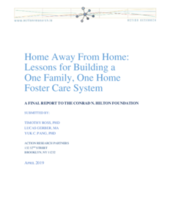Research findings and federal laws, including the recently passed Family First Act, emphasize the importance of placing children in family foster care when they cannot remain safely at home. The New York City Administration for Children’s Services (ACS) Foster Care Strategic Blueprint describes the many efforts ACS is making to fulfill this goal. These initiatives include increasing placements with kin as well as redesigning foster parent recruitment and support. Collectively, these initiatives are known as Home Away From Home.
This report describes lessons learned from a centerpiece of Home Away From Home: coaching, technical assistance, and data analysis activities funded by the Conrad N. Hilton Foundation and provided by Public Catalyst and Action Research in partnership with ACS. These activities aimed to improve the recruitment, training, support and retention of foster homes and build kinship caregiving capacity. In addition to intensive coaching provided to six foster care providers, Hilton funding supported regular meetings of Public Catalyst, Action Research and ACS leadership and staff to review and discuss data analyses, the range of strategies being implemented, and progress on targets for foster home recruitment and kinship placement.
The Home Away From Home activities align with a reconceptualization of foster care in New York City based on a One Family, One Home approach. This approach, based on research and diagnostic activity that informed the Foster Care Strategic Blueprint, aims to have each caregiver foster only one family group, whether that is a single child or a sibling group of two, three or more related children. The One Family, One Home approach has many advantages: keeping siblings together, reducing stress on children and caregivers, improving placement stability and other child welfare outcomes. One Family, One Home requires maintaining a family foster care pool of relative and nonrelative caregivers that is large enough to accommodate the number of family groups in foster care.

